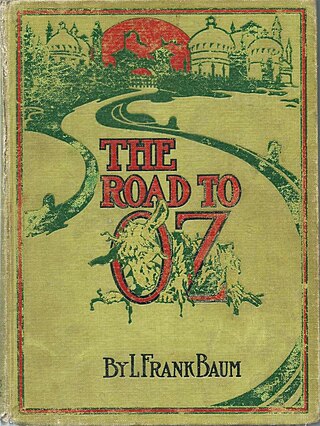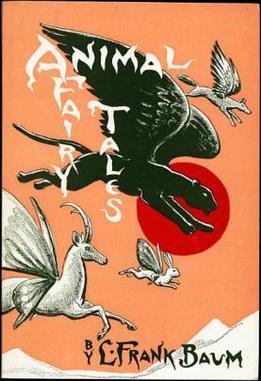Related Research Articles

Lyman Frank Baum was an American author best known for his children's fantasy books, particularly The Wonderful Wizard of Oz, part of a series. In addition to the 14 Oz books, Baum penned 41 other novels, 83 short stories, over 200 poems, and at least 42 scripts. He made numerous attempts to bring his works to the stage and screen; the 1939 adaptation of the first Oz book became a landmark of 20th-century cinema.

The Road to Oz is the fifth book in L. Frank Baum's Oz series. It was originally published on July 10, 1909 and documents the adventures of Dorothy Gale's fourth visit to the Land of Oz. It was followed by The Emerald City of Oz (1910).
Queen Lurline is a fictional character in the Oz books by L. Frank Baum and other authors.

Queen Zixi of Ix, or The Story of the Magic Cloak, is a children's book written by L. Frank Baum and illustrated by Frederick Richardson. It was originally serialized in the early 20th-century American children's magazine St. Nicholas from November 1904 to October 1905, and was published in book form later in 1905 by The Century Company. The events of the book alternate between Noland and Ix, two neighboring regions to the Land of Oz. Baum himself commented this was the best book he had yet written. In a letter to his eldest son, Frank Joslyn Baum, he said it was "nearer to the 'old-fashioned' fairy tale than anything I have yet accomplished," and in many respects, it adheres more closely to the fairy tale structure than the Oz books.

The Magical Mimics in Oz (1946) is the thirty-seventh book in the Oz series created by L. Frank Baum and his successors, and the first written by Jack Snow. It was illustrated by Frank G. Kramer. The novel was followed by The Shaggy Man of Oz (1949). The novel entered the public domain in the United States, when its copyright was not renewed as required.

The Life and Adventures of Santa Claus is a 1902 children's book, written by L. Frank Baum and illustrated by Mary Cowles Clark.

In traditional festive legend and popular culture, Santa Claus's reindeer are said to pull a sleigh through the night sky to help Santa Claus deliver gifts to children on Christmas Eve.

The Magic Cloak of Oz is a 1914 film directed by J. Farrell MacDonald. It was written by L. Frank Baum and produced by Baum and composer Louis F. Gottschalk. The film is an adaptation of Baum's 1905 novel, Queen Zixi of Ix.
The Baum Bugle: A Journal of Oz is the official journal of The International Wizard of Oz Club. The journal was founded in 1957, with its first issue released in June of that year. It publishes three times per year, with issues dated Spring, Autumn, and Winter; Issue No. 1 of Volume 50 appeared in the Spring of 2006. The journal publishes both scholarly and popular articles on L. Frank Baum, the Oz books written by Baum and other writers, and related subjects, plus reviews of Oz-related films and theater productions, rare photographs and illustrations, and similar materials.

American Fairy Tales is the title of a collection of twelve fantasy stories by L. Frank Baum, published in 1901 by the George M. Hill Company, the firm that issued The Wonderful Wizard of Oz the previous year. The cover, title page, and page borders were designed by Ralph Fletcher Seymour; each story was furnished with two full-page black-and-white illustrations, by either Harry Kennedy, Ike Morgan, or Norman P. Hall.

The Enchanted Island of Yew: Whereon Prince Marvel Encountered the High Ki of Twi and Other Surprising People is a children's fantasy novel written by L. Frank Baum, illustrated by Fanny Y. Cory, and published by the Bobbs-Merrill Company in 1903.

John Dough and the Cherub is a children's fantasy novel, written by American author L. Frank Baum, about a living gingerbread man and his adventures. It was illustrated by John R. Neill and published in 1906 by the Reilly & Britton Company. The story was serialized in the Washington Sunday Star and other newspapers from October to December 1906. Like the Oz books but unlike many of the author's other works, John Dough was issued under Baum's name rather than one of his pseudonyms. The book was popular; as late as 1919 it was selling 1500 copies a year. The 1974 Dover Publications edition features an introduction by Martin Gardner.

L. Frank Baum's Juvenile Speaker: Readings and Recitations in Prose and Verse, Humorous and Otherwise is an anthology of literary works by L. Frank Baum, author of the Oz books. The book was first published in 1910, with illustrations by veteran Baum artists John R. Neill and Maginel Wright Enright; a subsequent 1912 edition was retitled Baum's Own Book for Children. The book constitutes a complex element in the Baum bibliography.

Animal Fairy Tales is a collection of short stories written by L. Frank Baum, the creator of the Land of Oz series of children's books. The stories first received magazine publication in 1905. For several decades in the twentieth century, the collection was a "lost" book by Baum; it resurfaced when the International Wizard of Oz Club published the stories in one volume in 1969.

The Life and Adventures of Santa Claus is a 1985 Christmas stop motion animated television special. It was produced by Rankin/Bass Productions, based on the 1902 children's book The Life and Adventures of Santa Claus by L. Frank Baum, the writer of The Wonderful Wizard of Oz. The special first aired December 17, 1985 on CBS in the United States. This was Rankin/Bass's final "Animagic" stop motion production with later releases including traditional animation. Notably, this special was an adaptation of a novel and is not connected to the continuity created by previous Rankin/Bass Productions.
Nelebel's Fairyland is a twentieth-century fairy tale, a fantasy short story written by L. Frank Baum, famous as the creator of the Land of Oz. The story was first printed in the June 1905 issue of The Russ, the student newspaper of Russ High School in San Diego, California. It was reprinted in The Baum Bugle in 1962, and again in a 1980 collection of some of Baum's short fiction.
"The Runaway Shadows, or A Trick of Jack Frost" is a twentieth-century fairy tale, a fantasy short story written by L. Frank Baum, famous as the creator of the Land of Oz. The story is one of a small cluster of Baum narratives that involve his fantasy land the Forest of Burzee and its exotic denizens. Arguably, Burzee constitutes Baum's second most important fantasy realm after Oz itself, being employed in his novels The Life and Adventures of Santa Claus (1902) and Queen Zixi of Ix (1905) and several of his short stories, and is referenced in The Road to Oz (1909).

The Life & Adventures of Santa Claus is a 2000 American direct-to-video animated fantasy film created by Mike Young Productions and released by Universal Studios Home Entertainment. It is based on the 1902 L. Frank Baum novel of the same name.
This is a complete bibliography for American children's writer L. Frank Baum.
References
- ↑ Michael O'Neal Riley, Oz and Beyond: The Fantasy World of L. Frank Baum, Lawrence, KS, University Press of Kansas, 1997; p. 112.
- ↑ Henry Turner Bailey, ed., The School Arts Book, Vol. 4, Worcester, MA, Davis Publications, 1905; p. 299.
- ↑ L. Frank Baum, The Complete Life and Adventures of Santa Claus, Holicong, PA, Wildside Press, 2002.
- ↑ L. Frank Baum, L. Frank Baum's Book of Santa Claus, Radford, VA, Wilder Publications, 2007.
- ↑ Katharine M. Rogers, L. Frank Baum, Creator of Oz: A Biography, New York, St. Martin's Press, 2002; p. 102.
- ↑ L. Frank Baum, "A Kidnapped Santa Claus," The Baum Bugle, Vol. 12 No. 3 (Winter 1968).
- ↑ L. Frank Baum, A Kidnapped Santa Claus, Foreword by Martin Williams, Indianapolis, Bobbs-Merrill, 1969.
- ↑ "Santa's Castle (TV Movie 2018) - IMDb". IMDb .
- ↑ Christmas Castle (promotional title: Santa's Castle). Brain Power Studio, 2017. Tubit TV. https://tubitv.com/movies/456516/santas_castle